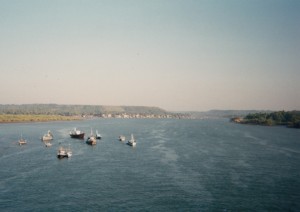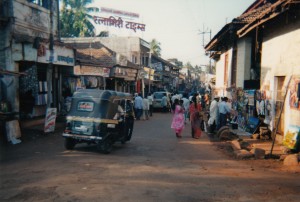Ratnagiri, March 7, 1998
The town is clustered on a hill, turned away from the sea.
There is a huge old banyan in the centre of the road that goes down the hill and a Ram Temple near it. This area is known as Ram Naka – after the the Ram temple – also as the Ram Naka Bazaar.
The main bazaar is the Hatora Bazaar and it is more or less the centre of the town: a few interlocking lanes with bright, bauble-filled shops all around it, and lots of cloth and copper vessels and other odds and ends.
The Kuchcheri is the centre of the civil lines; some of the old buildings are still in place – beautiful old laterite and brick buildings; with red-tiled roofs, but interspersed between them now are many all purpose concrete matchbox structures.
A road leads off from the kuchchehri to the side – this is, I think, the Civil Lines area. There’s a wide maidan at the centre; and a college building – quite possible this was earlier the court and the collectorate. The old collector’s house etc must have been somewhere in that area.
I couldn’t figure where the earlier Thebaw bungalow [where the last king of Burma spent most of his years in exile] might be. Asked everyone – no one seemed to know – all said that Thebaw lived in Thiba-palace. But I went to the market to get a shave and the barber told me that there was an earlier bungalow, called ‘Outram Bungalow’ – it is now known as the Bunglaow of the Asst Superintendent of Police – and that Thiba-raja used to live there. He said it was on Jail Road. Will have a look tomorrow (but I do remember that Desai* said the earlier bungalow had been torn down).
* W.S.Desai, author of India and Burma: A Study (Orient Longmans, Calcutta, 1954) & Deposed King Thebaw of Burma in India, 1885-1916, Bharatiya Vidya Series, Vol 25, (Bharatiya Vidya Bhavan, Bombay, 1967).




Sir, you wrote ‘Glass Palace’ before you actually visited Ratnagiri??
No, I visited it while I was writing ‘The Glass Palace’.
Amitav Ghosh